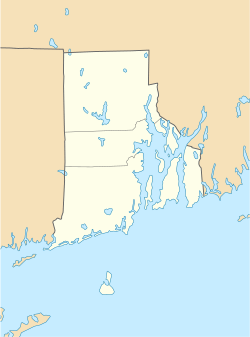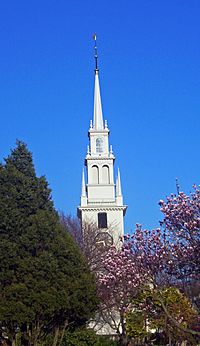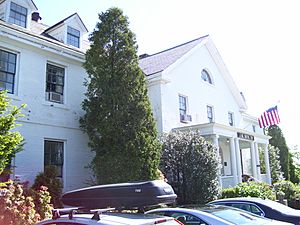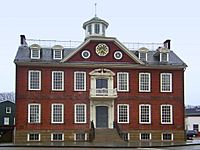Newport Historic District (Rhode Island) facts for kids
|
Newport Historic District
|
|
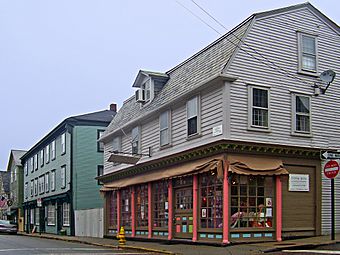
Colonial architecture at Spring and Church Streets, 2008
|
|
| Location | Newport, RI |
|---|---|
| Area | 250 acres (100 ha) |
| Built | late 17th-late 19th century |
| Architectural style | Georgian, Colonial, mix of later styles |
| NRHP reference No. | 68000001 |
Quick facts for kids Significant dates |
|
| Added to NRHP | November 24, 1968 |
| Designated NHLD | November 24, 1968 |
The Newport Historic District is a special area in Newport, Rhode Island. It covers about 250 acres (100 hectares) in the center of the city. This district was named a National Historic Landmark in 1968. It's famous for having many old buildings from the 1700s that are still in great shape. These buildings show what colonial life was like.
Six of these old buildings are also National Historic Landmarks on their own. This includes the oldest house in Newport and a building where the state government used to meet. Even though there are many historic buildings, newer ones also stand alongside them. The district is a popular place for tourists because of its rich history, its location near the water, and the shops along Thames Street. In 1997, it was even used as a filming location for the movie Amistad, pretending to be New Haven, Connecticut, in the 1800s.
Contents
Exploring the Newport Historic District
The Newport Historic District is located near Narragansett Bay. It includes the Easton's Point neighborhood, which has many colonial houses. You'll also find Washington Square and the busy shops along Thames Street. The area gently slopes up towards the Bellevue Avenue neighborhoods.
The district has different types of buildings. Along Thames Street and America's Cup Avenue, you'll see many shops and restaurants. The smaller side streets are mostly homes. These streets are very narrow because they were built long before cars existed. Because of this, only people who live there can park on these streets. The shops in the center of the district are mostly local restaurants and souvenir stores. You might also find a few well-known stores like Brooks Brothers or Starbucks.
A Glimpse into Newport's Past
Newport's Colonial Beginnings
The historic district is the original part of Newport. It was founded in 1639 and was the capital of the colony before the American Revolution. Some buildings still standing today are from the late 1600s. For example, the White Horse Tavern has been in the same spot since 1652, and its current building dates back to 1673. The Wanton-Lyman-Hazard House, built by 1697, is the city's oldest house museum. Most early homes were simple wooden houses, built in styles that fit the local materials.
In the early 1730s, people started to plan Newport's growth more formally. This led to the building of two important brick buildings: the Old Colony House and the Brick Market. These buildings show the Georgian style, which was popular in London. They were built to make Washington Square (then called the Parade) a grand public space, like those in English cities.
Newport was known for its religious freedom. This brought Quakers from Massachusetts and Sephardi Jews from Portugal. They built important places of worship. The Great Friends Meeting House on Marlborough Street, built in 1699, is the oldest church in Rhode Island. The Touro Synagogue is the oldest synagogue in the Western Hemisphere. Quakers settled a lot in Easton's Point, building many of the wooden houses there.
As Newport became a busy port, sea captains who became rich built larger homes. One of these, Hunter House, is now a National Historic Landmark. It's famous for its beautiful wooden furniture made by Newport craftsmen.
Newport in the 1800s
After the American Revolution, Newport was no longer the main capital of Rhode Island. That role went to Providence. However, the state government still met at the Colony House for some sessions. They also had a special meeting there every April to announce election results. This day was a big holiday in Newport for most of the 1800s.
During this century, the downtown area remained an important port, partly because of the nearby naval base. New buildings in styles like Italianate were built along Thames Street. Many of these businesses served sailors who were on leave.
Newport in the 1900s
After the Civil War, wealthy people started coming to Newport for summer vacations. They built huge homes near Bellevue Avenue. In 1900, the state government moved to Providence full-time. This made people more interested in saving Newport's old buildings. They created the Newport Historical Society to help restore places like the Wanton-Lyman-Hazard House and the Brick Market. Another group, the Preservation Society of Newport County, was formed to save the Hunter House from being torn down.
The city officially created the historic district in 1965, and it became a National Historic Landmark in 1968. In 1971, the naval fleet left Newport, which hurt the local economy. To help, the city allowed many old factories and warehouses near the water to be removed. New shops, hotels, and a new road called America's Cup Avenue were built.
Even after these changes, the historic district kept its special charm. In 1997, director Steven Spielberg chose Newport to film parts of Amistad. He felt it looked enough like New Haven, Connecticut, in the 1840s. Several historic buildings, especially the Colony House, were used as sets for the movie.
Important Buildings in the District
Many of the 392 buildings in the Newport Historic District are important because they add to its historic feel. This includes several National Historic Landmarks and other buildings listed on the National Register of Historic Places.
National Historic Landmarks to See
These buildings are very important and many are open to the public as museums.
- Brick Market: Built in 1762, this building is at the west end of Washington Square. It shows off a fancy and classic Georgian design. Today, it's the Museum of Newport History.
- Hunter House: Located on Washington Street, this is a beautiful Georgian wooden house. It has amazing woodworking and furniture made in Newport.
- Old Colony House: Found at the east end of Washington Square. This well-preserved Georgian building was where the colonial and state governments met. It's the fourth-oldest statehouse in the U.S.
- Trinity Church: This church, designed by local architect Richard Munday, is the oldest parish church in Rhode Island. Its tall white spire is a famous landmark. It's still an active church today.
- Vernon House: On Clarke Street, this is another excellent Georgian wooden house with perfect proportions.
- Wanton-Lyman-Hazard House: On Broadway, this is the oldest house in Newport, built by 1697. Its restoration shows how its style changed over time.
Other Registered Historic Places
- Army and Navy YMCA: This beautiful building on Washington Square was built in 1911. It was a popular spot for military members. Today, it provides housing.
- Great Friends Meeting House: On Marlborough Street, this building was constructed by Quakers in 1699. It is the oldest place of worship in Rhode Island.
- Touro Synagogue: Also designed by Peter Harrison, this synagogue on Touro Street dates from the 1720s. It is the oldest synagogue in the Western Hemisphere, built by the city's Jewish community from Portugal.
- White Horse Tavern: Located on Marlborough Street, this tavern has been in its current building since 1687. This makes it the oldest drinking establishment in the U.S.
Protecting Newport's History
To help keep the historic district special, the city created the Historic District Commission (HDC). This group of nine citizens makes sure that any changes to the outside of buildings in the district fit with its historic look. They review changes beyond simple repairs. The HDC helps protect not just this downtown district, but also other historic areas in Newport, like Bellevue Avenue.
Images for kids
-
Quaker-style clapboard house in Easton's Point


